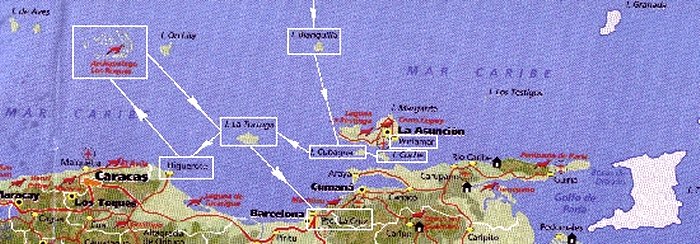
Puerto La Cruz
(8,560 Statute miles ; 13,775 Km)
June saw us heading south across the Caribbean Sea to the South American coast, seeking refuge for the hurricane season. We needn't have left so early but being rookies in tropical waters and having seen the havoc wrought, mainly by Lenny last year, caution seemed to be the order of the day. July has now passed without a tropical storm developing yet!
Our four day, 500 mile crossing was not without incident, we discovered Tropical Waves. These are the summer weather systems that spawn off the African coast and track westwards without developing into rotating storm systems. One of the first ones of the season caught us in mid passage with overnight, 35kt+ winds accompanied by big seas, heavy rain and intense lightening. Amoenitas acquitted herself well but we were pleased to be through it!

We made our landfall at Blanquilla, a six mile long island some 90 miles off Venezuela. The approach was dramatic as the island is only around 10 metres high, so after 500 miles at sea we couldn't see it until we were within a couple of miles. The water was also around 600m deep until we were within 500m of the anchorage just off the beach in the picture below.
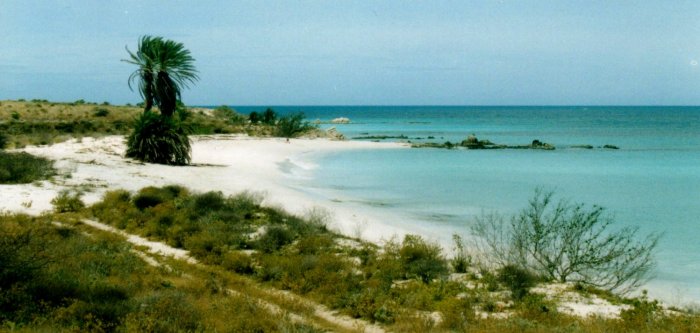
The island is arid, covered with cacti and virtually deserted except for the fishermen who come over from the mainland for a week or so at a time. We enjoyed the best snorkelling we had seen and did good trade with the fishermen for booze and cash (6 lobsters for $10US).
Margarita, our next island destination was a total contrast. It is very developed as a resort centre, the main town of Porlamar being one enormous, brash shopping emporium. It was a great place to restock though (Gordon's gin @ £1.50 a bottle and masses of that superb and cheap Argentinian beef our farmers won't let us import into the EU). We took a tour of the island with it's very varied vegetation and stopped off at the place below which sported a number of examples of tame local birdlife (the ones on the outside).

After the commercialism we were only too pleased to escape to the islands of Coche, Cubagua and Tortuga (turtle). They had fine, white sand beaches, clear turquoise seas and supported just a few fishing camps like the one in the picture below. Like Blanquilla, the islands are arid and uncomfortable to walk after around 10am when the sun gains strength.

We called in at Carenero, just east of Higuerote on the mainland to resupply for an extended period on Los Roques and saw for the first time the stark divide between this nation's many extremely poor and a small number of extremely rich. The plush marina/hotel complex we anchored outside was ringed by walls and razor wire fences, patrolled by guards touting automatic weapons. Immediately adjacent was a third world township without running water.
It was here that we first saw the variety of exotic bird species that we had expected to find in South America. Macaws, toucans, parrots and monochrome ibis's couldn't prepare us for the sight of flights of scarlet ibis winging in at sunset to dress a tree in the mangroves like some Yuletide spectacle with hundreds of bright red decorations.
Our primary destination was the National Park on the archipelago of Los Roques, some 80Nm off the coast from Caracas. The many islands are contained within an outer reef some 22Nm by 13Nm. On the chart below the land is green and water less than 2m deep is yellow. The whole area is a mass of coral reefs so navigation is by eyeball at the right time of day so as to distinguish depth by colour (dark blue OK, light blue shallow and brown bad news).

Fortunately, the area has been well protected, largely due to the relatively high price of staying there. It cost us £80 for the permit for the maximum allowed stay of two weeks. The attraction was the superb, quiet anchorages in the proximity of the most amazing coral reefs. Fish abounded both in species and numbers, in water of a clarity we had never witnessed before. Snorkelling over coral, sponges and sand in 8m of water with a visibility of in excess of 40m was akin to being suspended over a lunar surface.
Some of the hundreds of species of reef fish were amazing. The problem we have is how to identify many of them as our two reference books are not comprehensive enough. We swam amongst up to forty parrot fish, some 50cm long of six or seven differing markings and colours. It is odd when you are so close you can hear them attacking the coral with their powerful jaws and inspect the gashes they have made afterwards. Amongst our other favourites were the large, black/yellow lined French angel fish and the multi-coloured triggerfish. Di's least favourite are the large (up to 1.5m) barracuda that hover close but so far haven't attempted to approach. The other feature we noticed was the stability of the reef population. When one returned, all the same fish were hanging around their old haunts.
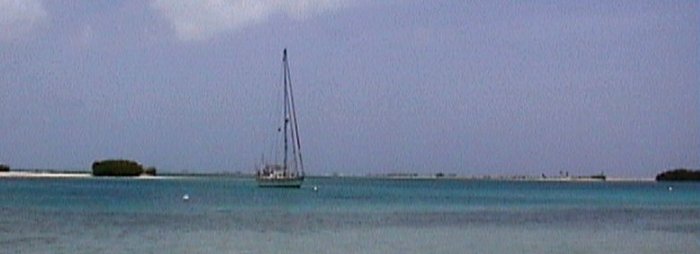
It was fitting that we celebrated our first anniversary of leaving on our trip in this magical paradise for sailors and divers. We had our diving compressor rigged on the aft deck for most of the stay and went out diving and snorkeling at least twice a day. In addition to the marine life, we had sea birds around and on the boat. This cheeky pelican decided our bimini sunshade was just the place to settle for a siesta. It made a change from the scary sound of them plummeting into the water beside us to catch fish in their capacious beaks.

Below we captured the unusual behaviour of the black headed gulls. Immediately after the pelican had caught a fish, it would land on the pelican's head, feet over it's eyes, hoping to snatch a morsel when the beak went up to swallow the fish. We spent hours watching pelicans fishing and gliding effortlessly just above the water.
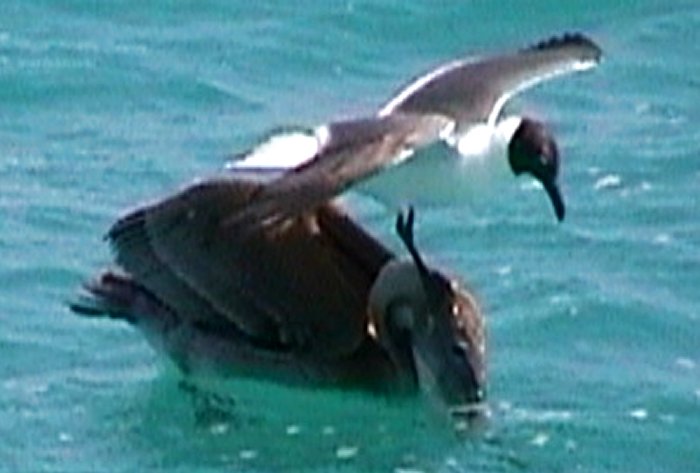
Los Roques has to be the best place we have visited yet but all good things have to come to an end. So, carrying our special memories, we set sail, skirting to the south of the prohibited area around the island naval base of Orchilla, back to Tortuga and then Puerto La Cruz. Such passages to the southeast have been difficult this year as the trade winds have lingered later than usual. bringing 20kt headwinds and 8-9ft wave heights. However, with Amoenitas's good windward performance plus the engine for the windfree inshore region, we made good time to the mainland. Motoring in Venezuelan waters isn't a problem with diesel fuel costing as much as 4.5p/litre (15 times cheaper than UK).
Here in Puerto La Cruz we are in a comfortable, friendly marina at the northern end of the El Morro complex. This is a labyrinth of canals bordered by the most lavishly appointed, multi million $ homes imaginable. Probably only weekend retreats too! We can get to the main town by bus or travel by inflatable to the Plaza Mayor where there is a good supermarket and shopping plaza. We are getting jobs done on the boat, socialising with the multi-national cruising community and of course making as much use of the pool as we can manage.

As in the rest of Venezuela, security is a constraint here. We are told almost to the nearest metre how far we can go on foot from the marina. and at what times. It's about 200m but even then a French couple from the marina were robbed at gunpoint a couple of weeks ago. At night we can hear the gunshots and notice that many of the election posters and banners have been shredded or pock marked by gunshot. In spite of the uncertainties, there is no way we would have missed this experience of South America. It's larger than life, a bit like the US and we are now looking forward to leaving the boat to do some inland travel by bus and plane.
As with the last update, it seems fitting to close with yet another sunset, this one from our favourite anchorage on the magical Los Roques.
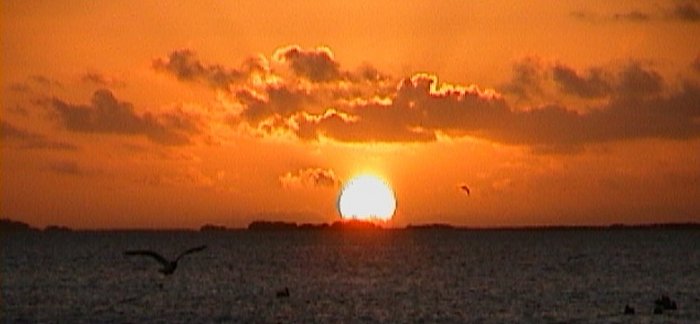
Where to next:-
As we mentioned, we are about to leave Amoenitas for the first time in thirteen months to explore the interior of Venezuela and maybe Peru. The Angel Falls, the worlds highest at over 1000m are a must. That will be a bus, light plane and canoe trip of three or four days. The town of Merida in the Andes offers some excellent walking and we may even make it to the Inca mountaintops of Peru if time permits.
We will be back at sea again by late August, on our way to Trinidad to haul out and refit early in October. Then we will complete our exploration of the Caribbean island chain by visiting Tobago and Grenada. That will bring us (hopefully) to the end of our first hurricane season. Plans for next year are still being researched but it seems highly likely that we won't retrace our route up the island chain but tackle the more challenging passage through the SW and NW Caribbean. Places like Nicaragua, Honduras, Belize, the Yucatan coast of Mexico, Cuba and Florida